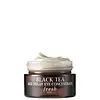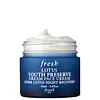What's inside
What's inside
 Key Ingredients
Key Ingredients

 Benefits
Benefits

 Concerns
Concerns

 Ingredients Side-by-side
Ingredients Side-by-side

Water
Skin ConditioningGlycerin
HumectantButylene Glycol
HumectantSqualane
EmollientPropylene Glycol Dicaprylate/Dicaprate
EmollientCaprylic/Capric Triglyceride
MaskingMethyl Methacrylate Crosspolymer
Pentylene Glycol
Skin ConditioningSteareth-21
CleansingCetyl Alcohol
EmollientStearyl Alcohol
EmollientC10-18 Triglycerides
EmollientLimnanthes Alba Seed Oil
Skin ConditioningSaccharomyces Ferment Filtrate
HumectantCamellia Sinensis Leaf Extract
AntimicrobialAvena Sativa Kernel Extract
AbrasiveMorinda Citrifolia Fruit Juice
Skin ConditioningSaccharomyces Cerevisiae Extract
Skin ConditioningLitchi Chinensis Seed Extract
Skin ConditioningRubus Fruticosus Leaf Extract
MaskingTocopheryl Acetate
AntioxidantAscorbyl Tetraisopalmitate
AntioxidantTocopherol
AntioxidantBiotin
AntiseborrhoeicGlyceryl Hydroxystearate
EmollientSteareth-2
EmulsifyingStearalkonium Hectorite
Gel FormingSodium Polyacrylate
AbsorbentParfum
MaskingDimethicone
EmollientSilica
AbrasivePropylene Carbonate
SolventAcrylates/C10-30 Alkyl Acrylate Crosspolymer
Emulsion StabilisingSodium Hyaluronate
HumectantMaltodextrin
AbsorbentTromethamine
BufferingAdenosine
Skin ConditioningCI 77891
Cosmetic ColorantBiosaccharide Gum-2
Skin ConditioningCaramel
Cosmetic ColorantHydroxyethylcellulose
Emulsion StabilisingAlgin
MaskingBHT
AntioxidantSodium Citrate
BufferingTin Oxide
AbrasiveAcacia Senegal Gum
MaskingCitric Acid
BufferingEthylhexylglycerin
Skin ConditioningPotassium Sorbate
PreservativeSerine
MaskingPhenoxyethanol
PreservativeLinalool
PerfumingWater, Glycerin, Butylene Glycol, Squalane, Propylene Glycol Dicaprylate/Dicaprate, Caprylic/Capric Triglyceride, Methyl Methacrylate Crosspolymer, Pentylene Glycol, Steareth-21, Cetyl Alcohol, Stearyl Alcohol, C10-18 Triglycerides, Limnanthes Alba Seed Oil, Saccharomyces Ferment Filtrate, Camellia Sinensis Leaf Extract, Avena Sativa Kernel Extract, Morinda Citrifolia Fruit Juice, Saccharomyces Cerevisiae Extract, Litchi Chinensis Seed Extract, Rubus Fruticosus Leaf Extract, Tocopheryl Acetate, Ascorbyl Tetraisopalmitate, Tocopherol, Biotin, Glyceryl Hydroxystearate, Steareth-2, Stearalkonium Hectorite, Sodium Polyacrylate, Parfum, Dimethicone, Silica, Propylene Carbonate, Acrylates/C10-30 Alkyl Acrylate Crosspolymer, Sodium Hyaluronate, Maltodextrin, Tromethamine, Adenosine, CI 77891, Biosaccharide Gum-2, Caramel, Hydroxyethylcellulose, Algin, BHT, Sodium Citrate, Tin Oxide, Acacia Senegal Gum, Citric Acid, Ethylhexylglycerin, Potassium Sorbate, Serine, Phenoxyethanol, Linalool
Water
Skin ConditioningGlycerin
HumectantIsononyl Isononanoate
EmollientGlyceryl Stearate
EmollientCaprylic/Capric Triglyceride
MaskingButylene Glycol
HumectantPentylene Glycol
Skin ConditioningC10-18 Triglycerides
EmollientDiglycerin
HumectantButyrospermum Parkii Butter
Skin ConditioningPEG-100 Stearate
Myristyl Myristate
EmollientNelumbo Nucifera Extract
Skin ConditioningPrunus Persica Leaf Extract
EmollientCitrus Limon Peel Oil
MaskingCucumis Sativus Fruit Extract
EmollientNelumbo Nucifera Flower Extract
Skin ConditioningAnthemis Nobilis Flower Oil
MaskingTocopheryl Acetate
AntioxidantTocopherol
AntioxidantBehenyl Alcohol
EmollientAmmonium Acryloyldimethyltaurate/Beheneth-25 Methacrylate Crosspolymer
Emulsion StabilisingCetearyl Alcohol
EmollientCetyl Palmitate
EmollientCocoglycerides
EmollientAcrylates/C10-30 Alkyl Acrylate Crosspolymer
Emulsion StabilisingParfum
MaskingSodium Hydroxide
BufferingT-Butyl Alcohol
PerfumingSodium Metabisulfite
AntioxidantBHT
AntioxidantTetrasodium EDTA
Ethylhexylglycerin
Skin ConditioningPotassium Sorbate
PreservativeSodium Benzoate
MaskingPhenoxyethanol
PreservativeLimonene
PerfumingBenzyl Salicylate
PerfumingCitral
PerfumingWater, Glycerin, Isononyl Isononanoate, Glyceryl Stearate, Caprylic/Capric Triglyceride, Butylene Glycol, Pentylene Glycol, C10-18 Triglycerides, Diglycerin, Butyrospermum Parkii Butter, PEG-100 Stearate, Myristyl Myristate, Nelumbo Nucifera Extract, Prunus Persica Leaf Extract, Citrus Limon Peel Oil, Cucumis Sativus Fruit Extract, Nelumbo Nucifera Flower Extract, Anthemis Nobilis Flower Oil, Tocopheryl Acetate, Tocopherol, Behenyl Alcohol, Ammonium Acryloyldimethyltaurate/Beheneth-25 Methacrylate Crosspolymer, Cetearyl Alcohol, Cetyl Palmitate, Cocoglycerides, Acrylates/C10-30 Alkyl Acrylate Crosspolymer, Parfum, Sodium Hydroxide, T-Butyl Alcohol, Sodium Metabisulfite, BHT, Tetrasodium EDTA, Ethylhexylglycerin, Potassium Sorbate, Sodium Benzoate, Phenoxyethanol, Limonene, Benzyl Salicylate, Citral
Ingredients Explained
These ingredients are found in both products.
Ingredients higher up in an ingredient list are typically present in a larger amount.
Acrylates/C10-30 Alkyl Acrylate Crosspolymer is a synthetic polymer. It is used to thicken and improve the texture of products. Due to its properties, it can prevent water and oil ingredients from separating.
BHT is a synthetic antioxidant and preservative.
As an antioxidant, it helps your body fight off free-radicals. Free-radicals are molecules that may damage your skin cells.
As a preservative, it is used to stabilize products and prevent them from degrading. Specifically, BHT prevents degradation from oxidation.
The concerns related to BHT come from oral studies; this ingredient is currently allowed for use by both the FDA and EU.
However, it was recently restricted for use in the UK as of April 2024.
Learn more about BHTButylene Glycol (or BG) is used within cosmetic products for a few different reasons:
Overall, Butylene Glycol is a safe and well-rounded ingredient that works well with other ingredients.
Though this ingredient works well with most skin types, some people with sensitive skin may experience a reaction such as allergic rashes, closed comedones, or itchiness.
Learn more about Butylene GlycolC10-18 Triglycerides is a skin conditioning and texture-enhancer.
It is created from glycerin and a mixture of C10-18 fatty acids.
This ingredient improves spreadability and helps thicken a product.
According to manufacturers, it usually comes from vegetable-based saturated fatty acids. Common bases for this ingredient are coconut oil, palm kernel oil, or both.
Due to the melting point being close to skin temperature, it is usually used in lip products.
Triglycerides are a main component of fat in the human body.
Learn more about C10-18 TriglyceridesThis ingredient is an emollient, solvent, and texture enhancer. It is considered a skin-softener by helping the skin prevent moisture loss.
It helps thicken a product's formula and makes it easier to spread by dissolving clumping compounds.
Caprylic Triglyceride is made by combining glycerin with coconut oil, forming a clear liquid.
While there is an assumption Caprylic Triglyceride can clog pores due to it being derived from coconut oil, there is no research supporting this.
Learn more about Caprylic/Capric TriglycerideEthylhexylglycerin (we can't pronounce this either) is commonly used as a preservative and skin softener. It is derived from glyceryl.
You might see Ethylhexylglycerin often paired with other preservatives such as phenoxyethanol. Ethylhexylglycerin has been found to increase the effectiveness of these other preservatives.
Glycerin is already naturally found in your skin. It helps moisturize and protect your skin.
A study from 2016 found glycerin to be more effective as a humectant than AHAs and hyaluronic acid.
As a humectant, it helps the skin stay hydrated by pulling moisture to your skin. The low molecular weight of glycerin allows it to pull moisture into the deeper layers of your skin.
Hydrated skin improves your skin barrier; Your skin barrier helps protect against irritants and bacteria.
Glycerin has also been found to have antimicrobial and antiviral properties. Due to these properties, glycerin is often used in wound and burn treatments.
In cosmetics, glycerin is usually derived from plants such as soybean or palm. However, it can also be sourced from animals, such as tallow or animal fat.
This ingredient is organic, colorless, odorless, and non-toxic.
Glycerin is the name for this ingredient in American English. British English uses Glycerol/Glycerine.
Learn more about GlycerinParfum is a catch-all term for an ingredient or more that is used to give a scent to products.
Also called "fragrance", this ingredient can be a blend of hundreds of chemicals or plant oils. This means every product with "fragrance" or "parfum" in the ingredients list is a different mixture.
For instance, Habanolide is a proprietary trade name for a specific aroma chemical. When used as a fragrance ingredient in cosmetics, most aroma chemicals fall under the broad labeling category of “FRAGRANCE” or “PARFUM” according to EU and US regulations.
The term 'parfum' or 'fragrance' is not regulated in many countries. In many cases, it is up to the brand to define this term.
For instance, many brands choose to label themselves as "fragrance-free" because they are not using synthetic fragrances. However, their products may still contain ingredients such as essential oils that are considered a fragrance by INCI standards.
One example is Calendula flower extract. Calendula is an essential oil that still imparts a scent or 'fragrance'.
Depending on the blend, the ingredients in the mixture can cause allergies and sensitivities on the skin. Some ingredients that are known EU allergens include linalool and citronellol.
Parfum can also be used to mask or cover an unpleasant scent.
The bottom line is: not all fragrances/parfum/ingredients are created equally. If you are worried about fragrances, we recommend taking a closer look at an ingredient. And of course, we always recommend speaking with a professional.
Learn more about ParfumPentylene glycol is typically used within a product to thicken it. It also adds a smooth, soft, and moisturizing feel to the product. It is naturally found in plants such as sugar beets.
The hydrophilic trait of Pentylene Glycol makes it a humectant. As a humectant, Pentylene Glycol helps draw moisture from the air to your skin. This can help keep your skin hydrated.
This property also makes Pentylene Glycol a great texture enhancer. It can also help thicken or stabilize a product.
Pentylene Glycol also acts as a mild preservative and helps to keep a product microbe-free.
Some people may experience mild eye and skin irritation from Pentylene Glycol. We always recommend speaking with a professional about using this ingredient in your routine.
Pentylene Glycol has a low molecular weight and is part of the 1,2-glycol family.
Learn more about Pentylene GlycolPhenoxyethanol is a preservative that has germicide, antimicrobial, and aromatic properties. Studies show that phenoxyethanol can prevent microbial growth. By itself, it has a scent that is similar to that of a rose.
It's often used in formulations along with Caprylyl Glycol to preserve the shelf life of products.
Potassium Sorbate is a preservative used to prevent yeast and mold in products. It is commonly found in both cosmetic and food products.
This ingredient comes from potassium salt derived from sorbic acid. Sorbic acid is a natural antibiotic and effective against fungus.
Both potassium sorbate and sorbic acid can be found in baked goods, cheeses, dried meats, dried fruit, ice cream, pickles, wine, yogurt, and more.
You'll often find this ingredient used with other preservatives.
Learn more about Potassium SorbateTocopherol (also known as Vitamin E) is a common antioxidant used to help protect the skin from free-radicals and strengthen the skin barrier. It's also fat soluble - this means our skin is great at absorbing it.
Vitamin E also helps keep your natural skin lipids healthy. Your lipid skin barrier naturally consists of lipids, ceramides, and fatty acids. Vitamin E offers extra protection for your skin’s lipid barrier, keeping your skin healthy and nourished.
Another benefit is a bit of UV protection. Vitamin E helps reduce the damage caused by UVB rays. (It should not replace your sunscreen). Combining it with Vitamin C can decrease sunburned cells and hyperpigmentation after UV exposure.
You might have noticed Vitamin E + C often paired together. This is because it is great at stabilizing Vitamin C. Using the two together helps increase the effectiveness of both ingredients.
There are often claims that Vitamin E can reduce/prevent scarring, but these claims haven't been confirmed by scientific research.
Learn more about TocopherolTocopheryl Acetate is AKA Vitamin E. It is an antioxidant and protects your skin from free radicals. Free radicals damage the skin by breaking down collagen.
One study found using Tocopheryl Acetate with Vitamin C decreased the number of sunburned cells.
Tocopheryl Acetate is commonly found in both skincare and dietary supplements.
Learn more about Tocopheryl AcetateWater. It's the most common cosmetic ingredient of all. You'll usually see it at the top of ingredient lists, meaning that it makes up the largest part of the product.
So why is it so popular? Water most often acts as a solvent - this means that it helps dissolve other ingredients into the formulation.
You'll also recognize water as that liquid we all need to stay alive. If you see this, drink a glass of water. Stay hydrated!
Learn more about Water